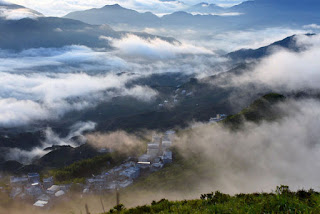Huangshan Maofeng , among “Top Ten Famous Teas” in China, is a green tea which came into being and became famous during Guangxu of the Qing Dynasty(1875-1908).
There are so many kinds of green tea in China. Then what green tea can be called as “Huangshan Maofeng”. A general view is that it should meet the following three points.
First, it should be produced from Huangshan. which we mean here a municipal-level administrative area, including 7 county-level administrative areas: Tunxi Qu, Huangshan Qu, Huizhou Qu, Shexian, Yixian, Xiuning, Qimen. Generally speaking, another two adjacent county-level areas, Wuyuan and Jixi should be also included because they both belonged to Huizhou which existed as as an administrative area equivalent to Huangshan City and doesn’t exist now. Huizhou seen as the old name of Huangshan City was in fact bigger than it and is still studied by scholars because of its cutural and historical significance.
Second, it should be made as a fired or baked green tea with the plucking standards of one bud with 1-3 leaves, generally speaking, harvested before “Gu Yu”(Grain Rain, around 20th April).
Third, it should be made of tealeaves harvested from Huangshan local cultivar named as”Huangshan Qunti Cultivar”. It is a sexual reproduced cultivar with genetic commingling.
Normally, Huangshan Maofeng was graded according to the plucking standards. One bud with one preliminarily extending leaf is considered as the highest grade, followed by one bud with one fully extending leaf, one bud with two leaves and one bud with three leaves. Of course, for tea produced from the same place, higher grade comes into market earlier than the lower grades. Here a precondition must be given because Huangshan is a mountainous area at an altitude between 200-1800meters. Every year, tea trees sprout at low altitude 5-15 days earlier than high altitude so it is possible that tea of low grade from the low altitude area may come into the market earlier than that of high grade from high altitude. One common misconception is that high grade guarantees good taste. In fact, plucking time can affect the quality of tea but it definitely doesn’t play the biggest role. For tea produced from the same place, tea harvested earlier normally gives more delicate taste than later one.
Then, what do we think is the most important factor in forming the unique taste and flavor of Huangshan Maofeng? We think it should be the producing place, exactly speaking, what is the natural village, even what hill or peak it is produced from. A producing place involves several vital parameters including soil, altitude, sunlight, rainfall.
There are more than 1300 natural villages and countless hills and peaks in Huangshan. Huangshan Maofeng producd from different natural villages, hills and peaks differs widely in taste and flavor. It is a challenging task to find out good producing places.
Fuxi, a Township-level administrative area, covering an area about 92.6 Square kilometers, is seen as the birthplace of Huangshan Maofeng. It is located in the north of Huizhou Qu, adjacent to Shexian on the east, bordering with Tangkou, the Southern Gate of Huangshan Scenic Area on the north, at an average altitude of 800 meters. Fuxi Huangshan Maofeng is outstanding in taste and flavor. That is why it always enjoys the highest premium prices among Huangshan Maofeng produced from all around Huangshan. Around in 1875, Xie Zheng’an, a man of Fuxi set up a tea house and make speciality green tea with improved traditional skills. He insisted using fresh tealeaves of one bud and one leaf. The first batch of tea was sent to Shanghai and made a great success unexpectedly. In the next few years, Huangshan Maofeng became famous not only domestically but also abroad. In Fuxi, a large numbers of tea trees planted from 1875 have been more than 100 years old. They still send forth tender buds and leaves of extraordinarily high quality every year because their long and robust roots deep into the earth can absorb much more sufficient nutrition than young tea trees.
 |
| Pre-Ming Fuxi Huangshan Mao Feng |
 |
| Pre-Ming Huangshan Mao Feng |
 |
| The Statue Of Xie Zheng'an In Fuxi Township |
 |
| Fuxi |
 |
| Fuxi |
In Huangshan, a few other places also produce outstanding Huangshan Maofeng although they are not as so famous as Fuxi. Wu Gong Ling is one of them. It is a village belonging to Shexian, covering an area about 1.4 Square kilometers, with a population about 2000 at an average altitude of 800 meters, featuring with terraced tea gardens about 0.82 Square kilometers reclaimed during 1960s and 1970s in high mountains. Wu Gong Ling literally means Centipedes Hill in Chinese. We are unable to figure out why it was given the name now. Wu Gong Long Huangshan Maofeng is also mellow, floral and flowering with good aftertaste.
 |
| Wu Gong Ling Huangshan Mao Feng |
 |
| Wu Gong Ling Huangshan Mao Feng |
 |
| Wu Gong Ling |
 |
| Wu Gong Ling |
 |
| Wu Gong Ling |
 |
| Wu Gong Ling |
We are glad to share with you more information of outstanding Huangshan Maofeng produced from different places in Huangshan in the future. Thank you!







































